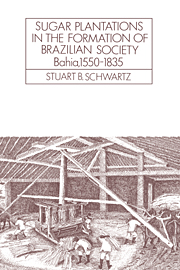Book contents
- Frontmatter
- Contents
- List of figures, maps, and tables
- Preface
- Abbreviations and special terms
- Weights and measures
- Dedication
- Part I Formations, 1500–1600
- Part II The Bahian engenhos and their world
- Part III Sugar society
- 9 A colonial slave society
- 10 The planters: masters of men and cane
- 11 The cane farmers
- 12 Wage workers in a slave economy
- 13 The Bahian slave population
- 14 The slave family and the limitations of slavery
- Part IV Reorientation and persistence, 1750–1835
- Appendixes
- Notes
- Glossary
- Sources and selected bibliography
- Sources of figures
- Index
- CAMBRIDGE LATIN AMERICAN STUDIES IN PRINT
13 - The Bahian slave population
Published online by Cambridge University Press: 05 May 2010
- Frontmatter
- Contents
- List of figures, maps, and tables
- Preface
- Abbreviations and special terms
- Weights and measures
- Dedication
- Part I Formations, 1500–1600
- Part II The Bahian engenhos and their world
- Part III Sugar society
- 9 A colonial slave society
- 10 The planters: masters of men and cane
- 11 The cane farmers
- 12 Wage workers in a slave economy
- 13 The Bahian slave population
- 14 The slave family and the limitations of slavery
- Part IV Reorientation and persistence, 1750–1835
- Appendixes
- Notes
- Glossary
- Sources and selected bibliography
- Sources of figures
- Index
- CAMBRIDGE LATIN AMERICAN STUDIES IN PRINT
Summary
This Bahia is a Land of Hottentots.
The count of Arcos (1765)The slave class was always little prolific, the number of births being comparatively small.
Opusculo Agricola-politico (Bahia, 1874)Slaves constituted the broad base of Bahian society, the bedrock on which it rested. By the beginning of the nineteenth century, about one-third of the captaincy's 500,000 inhabitants were enslaved; but in sugar-plantation zones, that proportion sometimes reached as high as 70 percent. We have already examined the nature of slave work, the characteristics of the plantation organization, and some aspects of master–slave relations. In this chapter, we will discuss the demographic features of the Bahian slaves in order to understand their life experiences and the range of opportunities and chances open to them. The use of a demographic approach is necessary because of the personal anonymity imposed on the majority of slaves by the documentary record. What remains is fragmentary, but it still contains enough information to suggest the conditions that Brazilian slaves endured. In the aggregated figures, we can perhaps recover some idea of personal experience.
From the gradual disappearance of Indian slavery in Bahia in the second and third decades of the seventeenth century until the end of the slave trade in 1850, the central fact of Bahian, and indeed Brazilian, slavery was the African origin of the majority of those in bondage.
- Type
- Chapter
- Information
- Sugar Plantations in the Formation of Brazilian SocietyBahia, 1550–1835, pp. 338 - 378Publisher: Cambridge University PressPrint publication year: 1986



